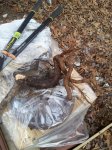Do you happen to know if brazillian pepper trees *can* be collected in standard 'yamadori' style, ie trunk-chopped and dug-up in 1 go? Because those suckers grow
very quickly, would love to collect some if they take to it!
Am in same position as OP, in FL and trying to find
native trees to collect- have bougies/crape/ilex/privet/etc but really want true natives not just 'yardadori', and bald cypress is all I've found....Buttonwood looks awesome, but I cannot discern Buttonwood from
Rhizophora (true 'Mangrove' trees), if anyone's got tips I'd love to hear them, I think buttonwoods may be just what I'm looking for ie a common, native plant that I can collect mature specimen in the aggressive 'trunk-chop&collect' manner ('1-stepping'), but BC's are the only native that seems to reliably handle that :/ Am close to just trying, blindly, to collect some common ones and see if they work (royal poincinas, melia azedarach's/'chinaberry'), would just be able to do sooo much if I knew what
native species took well to yamadori collection (ie stuff as forgiving as bougies, crapes, privet etc)
Whoa I'd given-up on finding American Elm in the Tampa area, very glad to read that

You wouldn't happen to have any recommendations on *where* to look, like habitats/preferences that I'd have higher chances of finding one? Like, with Black Olive (bucida spinosa), it looks awesome and I'd love to get one, but have never found one....Was only lucky enough to find the BC's because I at least knew to look on pond-edges!
Re quercus virginiana, I've tried sooo many times w/o luck, I did finally get a q.laurifolia ('laurel oak') to survive a collection but I probably tried 20+ between Live and Laurel before getting that....would really love to find something I can at least have fair 50/50 odds with lol! How well do sand pine and black gum take to collecting, is there anything special to keep in-mind or can they be lifted like I'd do with a privet or bougainvillea?
several times but my conscience always gets the best of me... I'm talking about anywhere south of Tampa. Mostly bald cypress, buttonwood, american elm.







